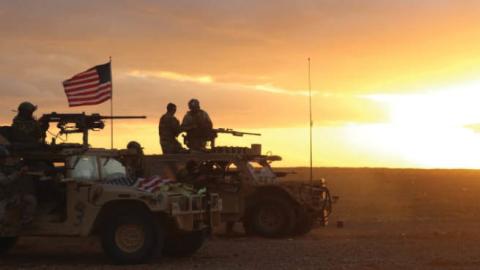President Trump’s decision to withdraw American troops from Syria should not have surprised anyone. He has consistently opposed U.S. military involvement in Syria, other than for the purposes of defeating the Islamic State terrorists and imposing penalties on the Assad regime for its use of chemical weapons. Similarly, there should be no great surprise if one day Trump orders U.S. troops to leave Afghanistan. He has been clear about his opposition to the U.S. presence there, too.
In defending his position, Trump sometimes describes his goal as ending “endless wars.” However, his policies have not always followed that trope. There are more U.S. forces overseas today than when his administration began. In the same week when he announced withdrawal of a thousand troops from Syria, he ordered an additional 2,000 to be deployed to Saudi Arabia.
But others, most prominently Senator Rand Paul and congresswoman and presidential candidate Tulsi Gabbard, use the term more expansively, summing up their foreign-policy vision as ending “endless wars.”
If an “endless war” is something to be avoided, we should first define what the term means. Then we should examine whether it is even possible to end such engagement, and, if it is, at what cost.
Does a long-term presence of American military forces constitute an “endless war”? If so, then World War II can be said never to have ended. U.S. forces have been on the territory of our former enemies in Germany, Italy, and Japan continuously since 1945 and currently number more than 100,000. That’s vastly more than we have in the Middle East.
By that definition, the Korean War did not end in 1953. Rather, it too is an “endless war,” as we have more than 25,000 American forces in South Korea today.
While the Rand Paul–Tulsi Gabbard alliance might favor withdrawal of all U.S. forces from Europe and Asia, most Americans don’t think of World War II or the Korean War as being “endless,” despite our substantial troop presence in those theaters. Probably that’s because our troops haven’t been involved in combat there in decades.
Mere troop presence, therefore, seems not to be the essence of an “endless war.” What about the existence of danger to our troops?
We have about a thousand military personnel on our base in Cuba. Tensions between the United States and Cuba have been so high that we did not even have formal relations for half a century, from 1961 to 2015. Does this tension and risk mean we’ve had an “endless war” with Cuba?
The U.S. Navy’s Fifth Fleet, together with some 4,000 American military personnel, is headquartered in Bahrain. That tiny country lies less than 500 miles from Iran — within easy striking distance of Iranian short-range missiles. Have we been in an “endless war” with Iran since the 1979 Iranian revolution that began with the U.S. hostage crisis? Our troops are certainly exposed to significant risk in the Persian Gulf.
Most Americans would not say we are in “endless wars” with Cuba or Iran.
We keep troops in Germany, Italy, Japan, South Korea, Cuba, and the Persian Gulf region for a reason. It is not to prolong “endless wars” that are in no sense actual wars. It is to protect American interests in preventing future wars.
What about Syria, Iraq, and Afghanistan?
We have roughly a thousand troops in Syria, about the same as in Cuba. It’s true that there is active combat in Syria, but it hasn’t much involved Americans. In the entire eight-year Syrian civil war, there have been a total of eight American service deaths. While even one death is tragic, more U.S. troops are killed in training accidents every year than in our entire time in Syria. This low level of U.S. participation doesn’t seem to fit the “endless war” thesis any more than our presence in Cuba does.
Beginning in 2003, we had a major war in Iraq. There have been over 4,500 U.S. military deaths in Iraq. Of those, 81, or fewer than 2 percent, occurred in the last seven years. The U.S. troop level in Iraq peaked at 166,000. Today, it’s around 5,000. So, if our presence in Iraq constitutes an “endless war,” then we are 97 percent of the way toward ending it.
Afghanistan might be a clearer example of an “endless war.”
Afghanistan has sometimes been called “America’s longest war.” It began a month after the American homeland was attacked on September 11, 2001. Since then, over 2,400 U.S. service personnel have been killed in action, including 14 this year. Our troop level peaked at 100,000 in 2010. Today our force in Afghanistan stands at about 14,000, alongside another 17,000 from numerous coalition-partner countries.
Comparing Afghanistan to Vietnam is instructive. Depending on how one marks the beginning of the Vietnam War, it could be considered a longer war than Afghanistan. America paid a huge price in Vietnam, with nearly 60,000 killed in action.
We have zero troops in Vietnam today. But the war did not exactly “end” when American troops left. In the immediate wake of the U.S. withdrawal, our South Vietnamese allies suffered tremendously. Millions of Vietnamese civilians were placed in prison camps or forced to flee at the hands of the victorious Communists. Hundreds of thousands were murdered, starved to death, or drowned at sea. Millions more were murdered soon after in the genocide in neighboring Cambodia. These were consequences of ending the “endless war” in Vietnam.
In Afghanistan, President Obama began our drawdown with a stated goal of removing all U.S. troops by the end of 2016. He reversed that decision and maintained 8,600 troops in place when he left office.
President Trump also sought to remove U.S. troops from Afghanistan, but seven months into office, he too reversed course, stating in August 2017 that “conditions on the ground, not arbitrary timetables, will guide our strategy from now on.” Trump increased our troop level by more than 5,000.
Neither Obama nor Trump could fairly be described as overeager to continue “endless wars.” Yet both came to the same conclusion about continuing some U.S. military presence in Afghanistan. As with the aftermath of our departure from Vietnam, concern about the consequences of full U.S. withdrawal weighed on the minds of two presidents who otherwise could scarcely be more different.
It turns out that defining “endless war” is not so easy, and ending one is not entirely attractive.
In the era of radical Islamic terrorism, keeping a U.S. military presence near our enemies serves a function similar to that of keeping a presence in Germany and South Korea. In Europe and Asia, our presence has helped prevent future war on a larger scale, as well as humanitarian catastrophes. Even the prospect of removal of U.S. forces from Syria is already having visible consequences. Withdrawal from Afghanistan might not end an “endless war.” It could lead to a bigger war down the road that is more dangerous for Americans.
In 1928, the United States and other leading countries signed the Kellogg-Briand Pact, which officially outlawed war. It was that generation’s attempt to end “endless wars.” Eleven years later, the same countries were immersed in the largest war the world has ever known.
In fact, no period in human history has been without wars. No one has ever figured out a way to permanently end them. The best we can do is prepare for them robustly, prevent them as aggressively as possible, and win them when we must.
Read in National Review



















